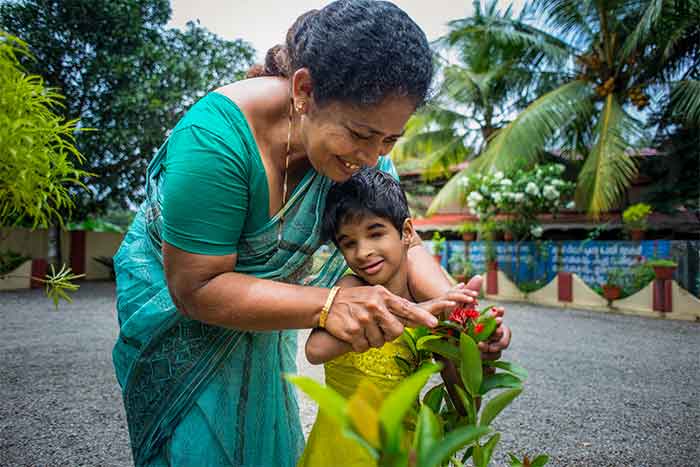
Since it started in early 2020 the COVID pandemic has posed great challenges for many with hearing and visual impairments, particularly children.
Talking with the help of hands or facial expression is the most convenient way for a person dealing with hearing impairment to communicate. Even a person with visual impairment requires support of objects and humans to move around or do their functions for many years in the beginning. So tactile support is their life line in a way.
“It was so hard to make my son Saransh (19) understand to go for isolation when he became COVID positive. He would get angry and cry when I would ask him to sleep or eat alone. In the first few days of his illness we all had to sleep with him with our faces covered with masks but later he began to adjust” says Saroj Patel, a home maker based at Ahmedabad in Gujarat.
Saransh is working with a local organization committed to train the children with deaf- blindness, which is a unique disability that combines varying degrees of both hearing and visual impairment. They teach him various skills for earning a livelihood and he is learning to make paper bags, plates and bowls as well as block printing.
Vimal Thawani, project director of Blind People’s Association told Covid Response Watch, “Due to the lockdown, these children had to stay inside homes all the time. When any one of them turned positive, they were not supposed to touch anyone and maintain social distance, which made it very difficult for them as well as for their caregivers. They found it difficult to understand and grapple with the situation.”
Closure of schools and institutes for a long time too made these children restless and agitated. Devyani Gupta, resident of Vaishali, Ghaziabad said, “My daughter Srishti (16 year girl with deafness) would get very upset when I told her that her school had been closed due to COVID . It was understandable as her world has been her classmates and teachers with whom she would spend so much time.”
She said Shrishti would calm down and accept the situation when her class teachers on video calls would explain the situation and show her the vacation days on the calendar.
Some of the problems of those with deaf-blindness have been compounded by myths about them that have become deep seated in society. According to Thawani, “people think that persons with deafness or blindness are aggressive and dangerous, which is absolutely incorrect. Other than this, they also misunderstand them as mentally challenged or intellectually disabled.”
She said that is possible that that people with hearing or visual loss try to communicate their thoughts in a way that others do not understand. So people need to show patience and sensitivity in order to understand them.
 Vinay Gopal, resident of Chandigarh narrated his experience of getting his son , Rishabh (15), with blindness, for jabs in the hospital. “When I took my son for vaccination, the nurse in the hospital got scared. She asked for a couple of helpers to be present and the head nurse also sat there. My son whom I had explained the process and the reasoning behind it got his vaccination calmly”. “
Vinay Gopal, resident of Chandigarh narrated his experience of getting his son , Rishabh (15), with blindness, for jabs in the hospital. “When I took my son for vaccination, the nurse in the hospital got scared. She asked for a couple of helpers to be present and the head nurse also sat there. My son whom I had explained the process and the reasoning behind it got his vaccination calmly”. “
“A few minutes after he got vaccinated, a woman who had also come to get vaccinated made a lot of noise while getting injected. My son asked that woman with a smile if she was alright. At that, the nurse and other present staff admired him saying that he was much better behaved than the woman patient!”
Reena Davefrom Chandigarh, mother of Ridhima (22) who is visually impaired, said that her daughter became apprehensive first when she was taken to a health centre for a RTPCR test among strangers. So they took her to another centre which had a few people whom she knew by voice and touch. This made her comfortable and she got her test done without any hesitation.
Thawani was of the opinion, “If we explain to such children well and make them comfortable, then they cooperate very well. ‘
“People living in the neighborhood and surroundings do not understand sign language or don’t know how to communicate with them, so they end up thinking that these people have behavioral issues, which is not true. The problem lies with the communication,” she said.
These children/adults face communication gaps not only with strangers but with family members as well. Quite surprisingly most of the parents and their family members too are not familiar with sign language.
Ashish Doval, project coordinator of Haryana Welfare Society for Persons with Speech and Hearing Impairment, (HWSPSHI) said, “Many formative years of these children are lost in consulting doctors when their impairment is diagnosed. Then they are urged to lip read to communicate, which further confuses them, as they fail to understand when they try to lip-read. This causes resentment which grows over time. There is even a term “Deaf Standard Time” when their pent–up emotions begin to burst out.”
According to him, “Parents or family members have limited communication with persons with hearing impairment at home. The communication is confined to terms for basic chores like ‘eat food, take bath, go to sleep’ etc. This limitation restricts the sphere of relationship these people share with their family members. Hence we encourage children as well as their family members to communicate in sign language, which is just like any other language and is a potent tool for the impaired children or persons to go ahead in life.”
Just like HWSPSHI, Sense International India too ran online courses in sign language, which were lapped up mostly by the parents. Akhil Paul, founder director of Sense International India told Covid Response Watch, “COVID proved a blessing in disguise as parents enrolled themselves for the online sign language courses. They felt the need more as children had to remain indoors and study from home.” Paul is the recipient of HSBC-Indo British Award 2003 for outstanding services to deaf-blind people for establishing 25 programmes in 13 states of India.
He discussed another aspect, which was the participation of fathers. “It is usually the mothers who bear the maximum responsibility of children (with deaf-blindness) at home, but during COVID the participation of fathers too grew, more so because it was mostly fathers who owned the smart phones, which were used to attend online classes,” he said.
Sense International India conducted collected data on the effect of COVID-19 on people with deaf blindness. Among some of the findings of the survey were that almost 50% of such persons had developed mental and health issues; 45.76% were stressed due during the pandemic or lock down. Around 67.56% such families borrowed money to meet their expenses; 36.29% did not receive their disability pension. Online classes were challenges for 50%. Besides this, 44.64% faced some kind of emotional abuse and 11.53% even reported this to the police.
Shrutilata Singh, Specialist Network Support with Sense International India told Covid Response Watch, “Our organization ran a specific campaign of fundraising to support such deserving families with basic smartphones with a long term data plan. The family members have been the conduit for training their children/ young adults with deaf-blindness and multiple disabilities.”
On the rise in mental health issues, she said, ”It was realized that during the pandemic that tackling mental health issues was one of the crucial needs so we hired qualified counselors who started training parents/ field workers/ special educators and coordinators in basic mental health training. So far, we have run four regional level workshops and three state level workshops to identify mental health issues and intervene.”
Note: Names of children and their parents were changed on their request.
Seema Sharma is a Chandigarh based freelance journalist who writes about environment, climate change, human rights and gender issues . She tweets at seema_ env













































